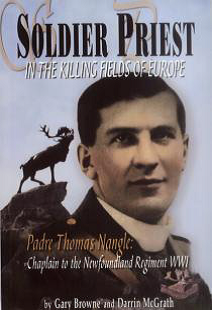Soldier Priest in the Killing
Fields of Europe:
Padre Thomas Nangle,
Chaplain to the Newfoundland
Regiment, WW1
Gary Browne and Darrin
Michael McGrath
DRC Publishing, St. John's, 2006
ISBN 0978149610
 Many of us are familiar with the haunting beauty of the
Newfoundland Memorial Park at Beaumont Hamel in France, where the
Newfoundland Regiment was almost annihilated on the opening day of the Battle
of the Somme, 01 July 1916. But relatively few of us are familiar with the
story of how this park came into being. This book, published in 2006 but,
apparently, never widely circulated, goes far toward filling this gap in our
historical record, recording the career of a remarkable man, Thomas Nangle.
Many of us are familiar with the haunting beauty of the
Newfoundland Memorial Park at Beaumont Hamel in France, where the
Newfoundland Regiment was almost annihilated on the opening day of the Battle
of the Somme, 01 July 1916. But relatively few of us are familiar with the
story of how this park came into being. This book, published in 2006 but,
apparently, never widely circulated, goes far toward filling this gap in our
historical record, recording the career of a remarkable man, Thomas Nangle.
Nangle was born in St. John's, Newfoundland, in 1889. He completed primary
school there before going to Ireland to study for the priesthood. He was
ordained in St. John's in 1913. He later became a chaplain with the
Newfoundland Regiment, and the tale of the regiment's ordeal on the Western
Front is told in the tally of dead and wounded that Nangle had to confront after
every engagement.
But Nangle is best known for his exploits after the war ended, when he was
named Newfoundland's Director of Grave Registration and Enquiry, and also as
Newfoundland's representative on the (then) Imperial War Graves Commission. In
these capacities, Nangle was responsible for finding the remains of
Newfoundland's casualties and moving them to final resting places in IWGC
cemeteries, exhausting, dispiriting and dangerous work.
Nangle was also charged with responsibility for developing suitable
memorials for Newfoundland's fallen. This resulted in the construction of five
memorial sites in France and Belgium, with the largest and principal site at
Beaumont Hamel. Nangle also chose the design and arranged for the production
of the statue of the Woodland Caribou stag, "The Monarch of the Topsails",
that graces each site, thereby creating the "Trail of the Caribou."
It is clear from this book that Nangle threw himself into this work with
tremendous passion and dedication. But, having completed all of this work,
in 1926 he threw it all up, resigned from the priesthood, and moved to Rhodesia.
The authors were unable to find any relevant records, but the studied (and,
with hindsight, appalling) refusal by both ecclesiastical and temporal
authorities to grant him any significant official recognition for his
accomplishments might well have been a factor. Nangle never returned to
Newfoundland, and he virtually disappeared from public consciousness.
In Rhodesia, in 1929, Nangle married Thelma Watkinson. They had three sons,
Timothy (1930), Hugh (1935), Rory (1940), and one daughter, Mavourneen (1942).
In 1962, Hugh emigrated to Toronto, married and settled there. Mavourneen
moved to Montreal and later Australia. In 1966, Nangle returned to Europe to
attend ceremonies at Beaumont Hamel marking the 50th anniversary of the Battle
of the Somme, and then went on to Canada to visit Hugh and Mavourneen. But
while in Canada he refused an invitation from Joey Smallwood to also visit
Newfoundland.
Thomas Nangle died in 1972 and is buried in Rhodesia.
This book was published in 2006 in time for the ninetieth anniversary of
the Battle of Beaumont Hamel. On that occasion the Royal Newfoundland Regiment
returned to Europe in strength to once again follow the "Trail of the Caribou".
And three of Nangle's children, Hugh, Rory and Mavourneen, accompanied them.
This is a most remarkable book. It has only 165 pages and is thus quite
intense, and the above is only the briefest summary of its contents. But much
of the story is told at first-hand through excerpts from letters written to
and by Nangle; these go far toward giving the book its sense of currency and
urgency. To my mind, an invaluable addition to our historical record. Most
highly recommended.

|

|
Last updated: 30 January 2017
|
 Many of us are familiar with the haunting beauty of the
Newfoundland Memorial Park at Beaumont Hamel in France, where the
Newfoundland Regiment was almost annihilated on the opening day of the Battle
of the Somme, 01 July 1916. But relatively few of us are familiar with the
story of how this park came into being. This book, published in 2006 but,
apparently, never widely circulated, goes far toward filling this gap in our
historical record, recording the career of a remarkable man, Thomas Nangle.
Many of us are familiar with the haunting beauty of the
Newfoundland Memorial Park at Beaumont Hamel in France, where the
Newfoundland Regiment was almost annihilated on the opening day of the Battle
of the Somme, 01 July 1916. But relatively few of us are familiar with the
story of how this park came into being. This book, published in 2006 but,
apparently, never widely circulated, goes far toward filling this gap in our
historical record, recording the career of a remarkable man, Thomas Nangle.